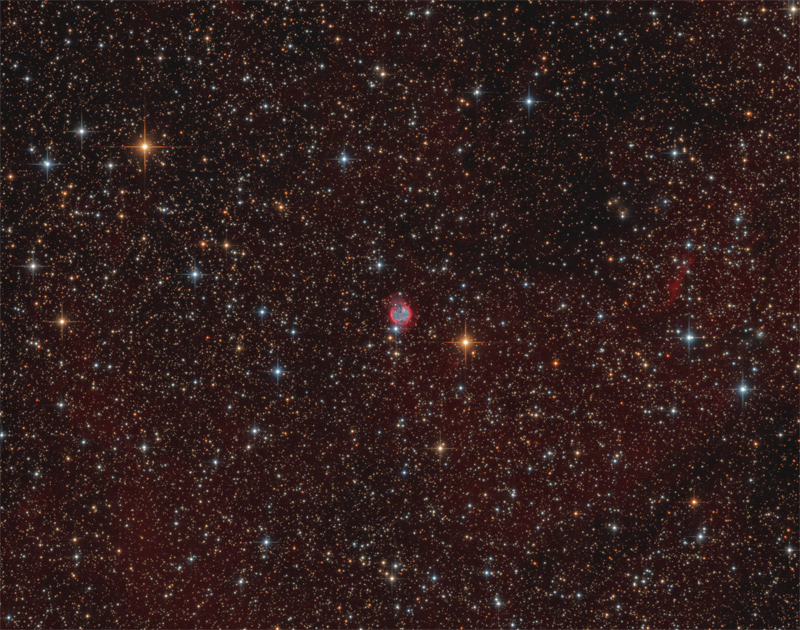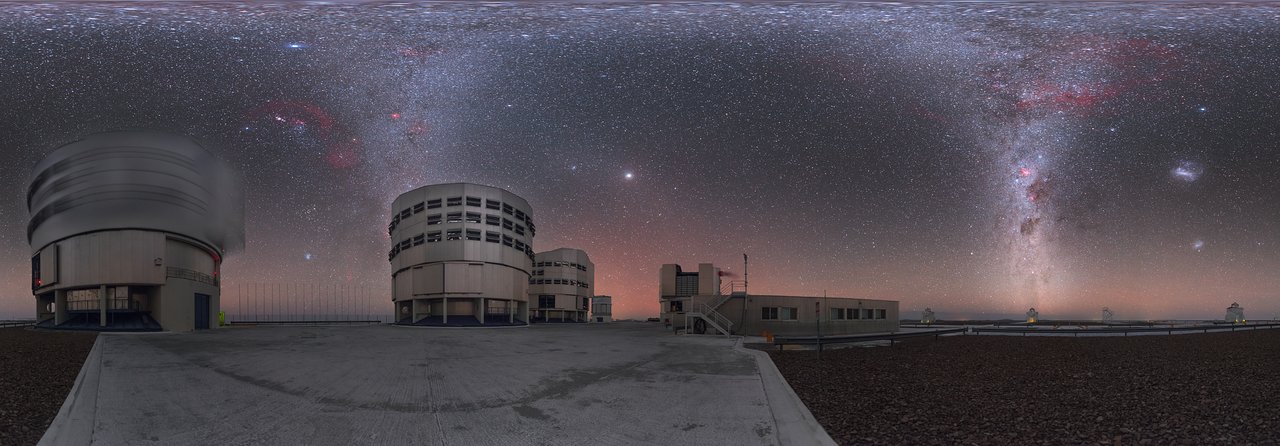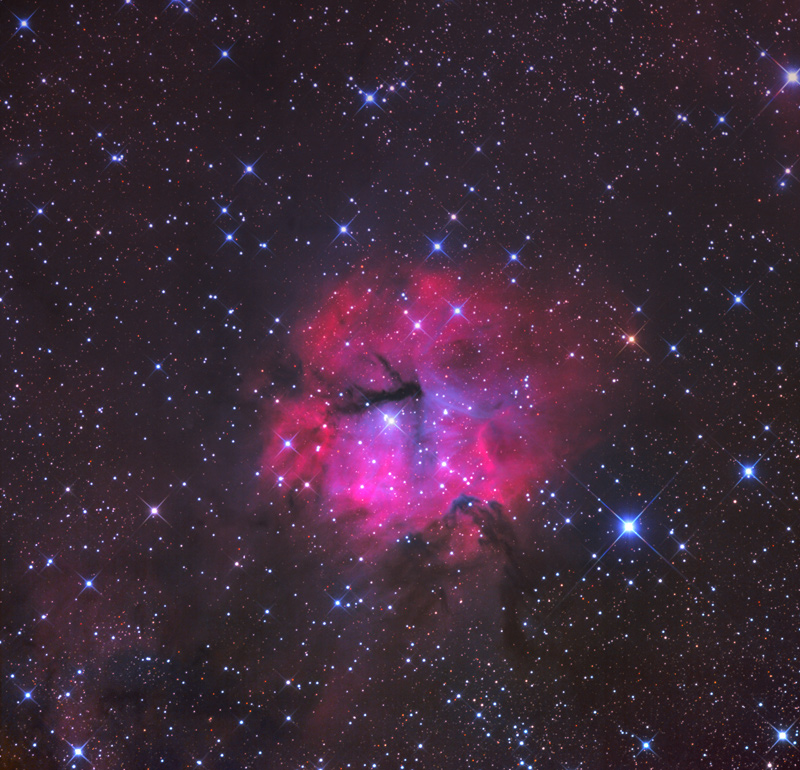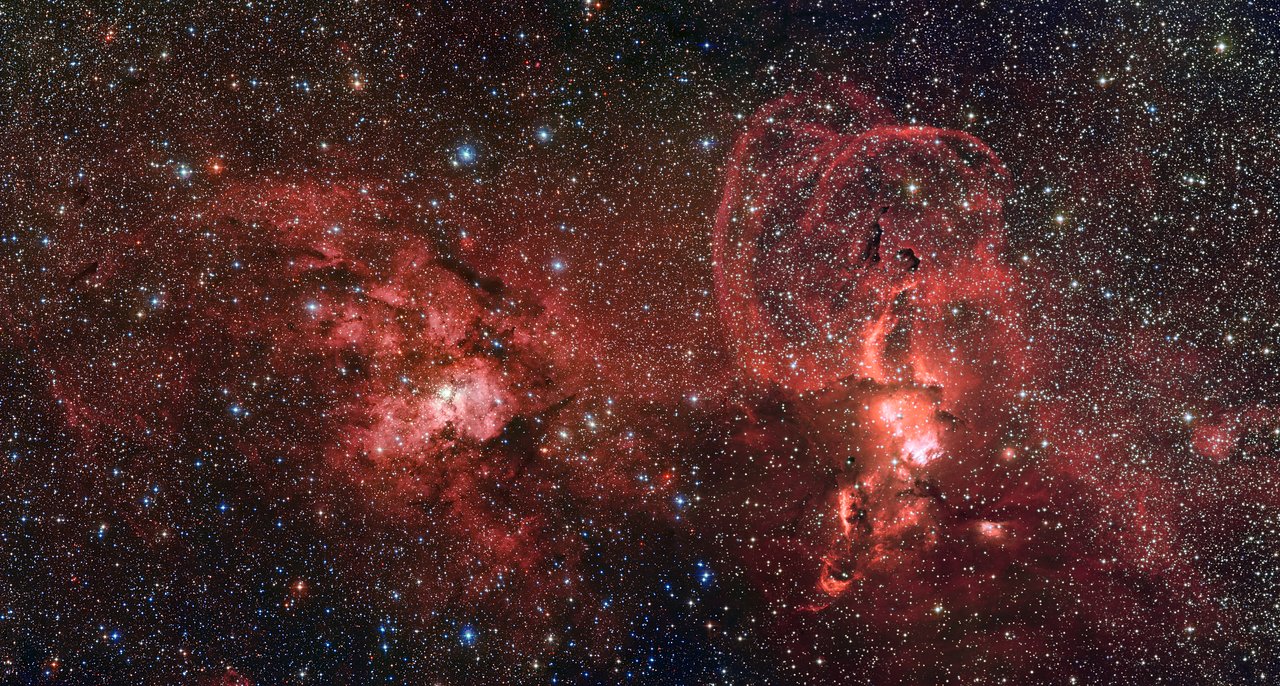Found Images: 2019 May
Found Images: 2019 May
Have you seen a great image or video somewhere that you think would make a great APOD? Nominate it for APOD! Please post as much information here as you have about the image/video with a link to any source(s) for it you know of here, and the editors will take a look.
When posting the image itself, please do not post anything larger than a thumbnail here; please honor the copyright holder's copyright.
Please keep hotlinked images under 400K.
Thank you!
<< Previously
Know the quiet place within your heart and touch the rainbow of possibility; be
alive to the gentle breeze of communication, and please stop being such a jerk. — Garrison Keillor
alive to the gentle breeze of communication, and please stop being such a jerk. — Garrison Keillor
-
starsurfer
- Stellar Cartographer
- Posts: 5409
- Joined: Thu Mar 15, 2012 7:25 pm
Re: Found Images: 2019 May
IPHASX J195749.2+290259
http://outters.fr/wp/iphasx195749_2_290259_ho_rgb/
Copyright: Nicolas Outters http://outters.fr/wp/iphasx195749_2_290259_sho_rgb/ You can find more information about this supernova remnant here. The planetary nebula near the top right corner is NGC 6842.
http://outters.fr/wp/iphasx195749_2_290259_ho_rgb/
Copyright: Nicolas Outters http://outters.fr/wp/iphasx195749_2_290259_sho_rgb/ You can find more information about this supernova remnant here. The planetary nebula near the top right corner is NGC 6842.
-
starsurfer
- Stellar Cartographer
- Posts: 5409
- Joined: Thu Mar 15, 2012 7:25 pm
-
starsurfer
- Stellar Cartographer
- Posts: 5409
- Joined: Thu Mar 15, 2012 7:25 pm
-
starsurfer
- Stellar Cartographer
- Posts: 5409
- Joined: Thu Mar 15, 2012 7:25 pm
Re: Found Images: 2019 May
NGC 1015
https://www.spacetelescope.org/images/potw1811a/
Copyright: ESA/Hubble & NASA, A. Riess (STScl/JHU)
https://www.spacetelescope.org/images/potw1811a/
Copyright: ESA/Hubble & NASA, A. Riess (STScl/JHU)
-
starsurfer
- Stellar Cartographer
- Posts: 5409
- Joined: Thu Mar 15, 2012 7:25 pm
Re: Found Images: 2019 May
Re: Found Images: 2019 May
Hubble's Spectacular Wide View of the Universe
http://hubblesite.org/image/4493/news_release/2019-17
Ann
http://hubblesite.org/image/4493/news_release/2019-17
Larger versions of the new Hubble Deep Field can be found here.Hubblesite wrote:
This Hubble Space Telescope image represents a portion of the Hubble Legacy Field, one of the widest views of the universe ever made.
The image, a combination of thousands of snapshots, represents 16 years' worth of observations.
The Hubble Legacy Field includes observations taken by several Hubble deep-field surveys, including the eXtreme Deep Field (XDF), the deepest view of the universe. The wavelength range stretches from ultraviolet to near-infrared light, capturing all the features of galaxy assembly over time. This cropped image mosaic presents a wide portrait of the distant universe and contains roughly 200,000 galaxies. They stretch back through 13.3 billion years of time to just 500 million years after the universe's birth in the big bang.
Ann
Color Commentator
Re: Found Images: 2019 May
Ann wrote: ↑Sun May 05, 2019 6:26 pm Hubble's Spectacular Wide View of the Universe
http://hubblesite.org/image/4493/news_release/2019-17
viewtopic.php?t=39393
Know the quiet place within your heart and touch the rainbow of possibility; be
alive to the gentle breeze of communication, and please stop being such a jerk. — Garrison Keillor
alive to the gentle breeze of communication, and please stop being such a jerk. — Garrison Keillor
ESO: The Twin Pillars of the Milky Way
The Twin Pillars of the Milky Way
ESO Picture of the Week | 2019 May 06
ESO Picture of the Week | 2019 May 06
This striking UHD panorama shows a bizarre-looking scene at ESO’s Paranal Observatory, home to ESO’s Very Large Telescope (VLT). The Milky Way graces the skies above the observing site every single night, and is visible in stunning detail and clarity. But here, the galaxy appears to dip down through the night sky and create two separate columns, while still filling the sky towards the top of the frame. Why is this view so distorted?
The sculpting and reshaping of this familiar celestial scene result from the way in which the photographer, ESO Photo Ambassador Petr Horálek, captured the image. Horálek photographed the entire dome of the sky, from zenith to horizon, a full 360 degrees around. The “two Milky Ways” are in fact a single band — the plane of our galaxy as it arcs across the sky from horizon to horizon. As it passes overhead, it appears to spread out across the top edge of the panorama due to the distortion needed to squeeze the full dome of the sky into a flat, rectangular image.
Although the Milky Way steals the show, many other notable celestial objects are visible here. The blueish spot between the two leftmost telescope domes (one of which is blurred because it was moving at the time!) is the Pleiades star cluster. Above the Pleiades sit the Orion Nebula, Barnard’s Loop, and the pink Rosette Nebula. At the centre of the image, Jupiter stands out brightly. The orange glow just below Jupiter is produced by an optical phenomenon known as airglow, which is often seen in extremely dry atmospheric conditions such as those found at Paranal (in the Chilean Atacama Desert). Captured within the rising, smoke-like chimney of the Milky Way on the right are the Gum Nebula, Carina Nebula, and the dark Coalsack Nebula— and the two Magellanic Clouds are visible as bright smudges towards the right edge of the frame.
Know the quiet place within your heart and touch the rainbow of possibility; be
alive to the gentle breeze of communication, and please stop being such a jerk. — Garrison Keillor
alive to the gentle breeze of communication, and please stop being such a jerk. — Garrison Keillor
HEIC: Distant and Ancient (SPT0615)
Distant and Ancient
ESA Hubble Picture of the Week | 2019 May 06
ESA Hubble Picture of the Week | 2019 May 06
Dotted across the sky in the constellation of Pictor (The Painter’s Easel) is the galaxy cluster highlighted here by the NASA/ESA Hubble Space Telescope: SPT-CL J0615-5746, or SPT0615 for short. First discovered by the South Pole Telescope less than a decade ago, SPT0615 is exceptional among the myriad clusters so far catalogued in our map of the Universe — it is the highest-redshift cluster for which a full, strong lens model is published.
SPT0615 is a massive cluster of galaxies, one of the farthest observed to cause gravitational lensing. Gravitational lensing occurs when light from a background object is deflected around mass between the object and the observer. Among the identified background objects, there is SPT0615-JD, a galaxy that is thought to have emerged just 500 million years after the Big Bang. This puts it among the very earliest structures to form in the Universe. It is also the farthest galaxy ever imaged by means of gravitational lensing.
Just as ancient paintings can tell us about the period of history in which they were painted, so too can ancient galaxies tell us about the era of the Universe in which they existed. To learn about cosmological history, astronomers explore the most distant reaches of the Universe, probing ever further out into the cosmos. The light from distant objects travels to us from so far away that it takes an immensely long time to reach us, meaning that it carries information from the past — information about the time at which it was emitted.
By studying such distant objects, astronomers are continuing to fill the gaps in our picture of what the very early Universe looked like, and uncover more about how it evolved into its current state.
Know the quiet place within your heart and touch the rainbow of possibility; be
alive to the gentle breeze of communication, and please stop being such a jerk. — Garrison Keillor
alive to the gentle breeze of communication, and please stop being such a jerk. — Garrison Keillor
-
starsurfer
- Stellar Cartographer
- Posts: 5409
- Joined: Thu Mar 15, 2012 7:25 pm
Re: Found Images: 2019 May
NGC 2014, NGC 2020 and NGC 2032
http://www.karelteuwen.be/photo_page.ph ... 4&album=19
Copyright: Karel Teuwen NGC 2014 is an emission nebula with an associated cluster near the right. NGC 2020 is the green Wolf Rayet bubble below it. NGC 2032 is part of the complex on the left.
http://www.karelteuwen.be/photo_page.ph ... 4&album=19
Copyright: Karel Teuwen NGC 2014 is an emission nebula with an associated cluster near the right. NGC 2020 is the green Wolf Rayet bubble below it. NGC 2032 is part of the complex on the left.
-
starsurfer
- Stellar Cartographer
- Posts: 5409
- Joined: Thu Mar 15, 2012 7:25 pm
Re: Found Images: 2019 May
-
starsurfer
- Stellar Cartographer
- Posts: 5409
- Joined: Thu Mar 15, 2012 7:25 pm
-
starsurfer
- Stellar Cartographer
- Posts: 5409
- Joined: Thu Mar 15, 2012 7:25 pm
-
starsurfer
- Stellar Cartographer
- Posts: 5409
- Joined: Thu Mar 15, 2012 7:25 pm
Re: Found Images: 2019 May
IC 4685, NGC 6559, IC 1274 and IC 1275
https://www.flickr.com/photos/astroshed/7182553577/
Copyright: Eddie Trimarchi
https://www.flickr.com/photos/astroshed/7182553577/
Copyright: Eddie Trimarchi
-
starsurfer
- Stellar Cartographer
- Posts: 5409
- Joined: Thu Mar 15, 2012 7:25 pm
Re: Found Images: 2019 May
-
starsurfer
- Stellar Cartographer
- Posts: 5409
- Joined: Thu Mar 15, 2012 7:25 pm
Re: Found Images: 2019 May
vdB136 and LBN 312
http://afesan.es/Deepspace/slides/vdB%2 ... us%29.html
Copyright: Antonio Sánchez
http://afesan.es/Deepspace/slides/vdB%2 ... us%29.html
Copyright: Antonio Sánchez
ESO: The Birth of the Hunter (NGC 2023)
The Birth of the Hunter
ESO Picture of the Week | 2019 May 13
ESO Picture of the Week | 2019 May 13
The constellation of Orion (The Hunter) is one of the most recognisable collections of stars in the night sky. We have noted Orion’s prominent stars for tens of thousands of years at least, and likely far longer. Chinese astronomers called it 参宿 or Shēn, literally “three stars”, for its three bright dots (which form the Hunter’s belt). The ancient Egyptians regarded it as the gods Sah and Sopdet, manifestations of Osiris and Isis, respectively, whereas Greek astronomers saw a brave hunter — the eponymous Orion — with his sword above his head, ready to strike.
Mythology aside, Orion is a fascinating patch of sky. This image, from ESO's Very Large Telescope (VLT), shows a reflection nebula nestled at the heart of the constellation — NGC 2023. Located close to the well-known Horsehead and Flame Nebulae, NGC 2023 lurks about 1500 light-years away from Earth, and is one of the largest reflection nebulae in the sky.
Reflection nebulae are clouds of interstellar dust that reflect the light from nearby or internal sources, like fog around a car headlight. NGC 2023 is illuminated by a massive young star named HD 37903. The star is extremely hot — several times hotter than the Sun — and its bright blue-white light causes NGC 2023’s milky glow. Such nebulae are often the birthplaces of stars, and contain a clumpy distribution of gas that’s significantly denser than the surrounding medium. Under the influence of gravity, these clumps attract one another and merge, eventually creating a new star. In a few million years time, Orion's Belt may gain a new star!
The image was taken with the VLT’s FORS (FOcal Reducer and Spectrograph) instrument as part of the ESO Cosmic Gems programme. This initiative produces images of interesting and visually attractive objects using ESO telescopes, for the purposes of education and outreach. The programme makes use of telescope time that cannot be used for science observations. All data collected may also be suitable for scientific purposes, and are made available to astronomers through ESO’s science archive.
Know the quiet place within your heart and touch the rainbow of possibility; be
alive to the gentle breeze of communication, and please stop being such a jerk. — Garrison Keillor
alive to the gentle breeze of communication, and please stop being such a jerk. — Garrison Keillor
HEIC: Settling into Old Age (NGC 3384)
Settling into Old Age
ESA Hubble Picture of the Week | 2019 May 13
ESA Hubble Picture of the Week | 2019 May 13
NGC 3384, visible in this image, has many of the features characteristic of so-called elliptical galaxies. Such galaxies glow diffusely, are rounded in shape, display few visible features, and rarely show signs of recent star formation. Instead, they are dominated by old, ageing, and red-hued stars. This stands in contrast to the sprightliness of spiral galaxies such as our home galaxy, the Milky Way, which possess significant populations of young, blue stars in spiral arms swirling around a bright core.
However, NGC 3384 also displays a hint of disc-like structure towards its centre, in the form of a central ‘bar’ of stars cutting through its centre. Many spirals also boast such a bar, the Milky Way included; galactic bars are thought to funnel material through and around a galaxy’s core, helping to maintain and fuel the activities and processes occurring there.
NGC 3384 is located approximately 35 million light-years away in the constellation of Leo (The Lion). This image was taken using the NASA/ESA Hubble Space Telescope’s Advanced Camera for Surveys (ACS).
Know the quiet place within your heart and touch the rainbow of possibility; be
alive to the gentle breeze of communication, and please stop being such a jerk. — Garrison Keillor
alive to the gentle breeze of communication, and please stop being such a jerk. — Garrison Keillor
-
starsurfer
- Stellar Cartographer
- Posts: 5409
- Joined: Thu Mar 15, 2012 7:25 pm
Re: ESO: The Birth of the Hunter (NGC 2023)
bystander wrote: ↑Mon May 13, 2019 4:06 pm The Birth of the Hunter
ESO Picture of the Week | 2019 May 13The constellation of Orion (The Hunter) is one of the most recognisable collections of stars in the night sky. We have noted Orion’s prominent stars for tens of thousands of years at least, and likely far longer. Chinese astronomers called it 参宿 or Shēn, literally “three stars”, for its three bright dots (which form the Hunter’s belt). The ancient Egyptians regarded it as the gods Sah and Sopdet, manifestations of Osiris and Isis, respectively, whereas Greek astronomers saw a brave hunter — the eponymous Orion — with his sword above his head, ready to strike.
Mythology aside, Orion is a fascinating patch of sky. This image, from ESO's Very Large Telescope (VLT), shows a reflection nebula nestled at the heart of the constellation — NGC 2023. Located close to the well-known Horsehead and Flame Nebulae, NGC 2023 lurks about 1500 light-years away from Earth, and is one of the largest reflection nebulae in the sky.
Reflection nebulae are clouds of interstellar dust that reflect the light from nearby or internal sources, like fog around a car headlight. NGC 2023 is illuminated by a massive young star named HD 37903. The star is extremely hot — several times hotter than the Sun — and its bright blue-white light causes NGC 2023’s milky glow. Such nebulae are often the birthplaces of stars, and contain a clumpy distribution of gas that’s significantly denser than the surrounding medium. Under the influence of gravity, these clumps attract one another and merge, eventually creating a new star. In a few million years time, Orion's Belt may gain a new star!
The image was taken with the VLT’s FORS (FOcal Reducer and Spectrograph) instrument as part of the ESO Cosmic Gems programme. This initiative produces images of interesting and visually attractive objects using ESO telescopes, for the purposes of education and outreach. The programme makes use of telescope time that cannot be used for science observations. All data collected may also be suitable for scientific purposes, and are made available to astronomers through ESO’s science archive.
NGC 2023.Steve Mazlin, Mark Hanson, Warren Keller, Rex Parker, Tommy Tse,
and Peter Proulx (SSRO / PROMPT / CTIO)
and Peter Proulx (SSRO / PROMPT / CTIO)
I prefer the APOD.
Ann
Color Commentator
-
starsurfer
- Stellar Cartographer
- Posts: 5409
- Joined: Thu Mar 15, 2012 7:25 pm
-
starsurfer
- Stellar Cartographer
- Posts: 5409
- Joined: Thu Mar 15, 2012 7:25 pm
Re: Found Images: 2019 May
Dumbbell Nebula (M27)
https://www.flickr.com/photos/avdhoeven ... 489023576/
Copyright: Andre van der Hoeven
https://www.flickr.com/photos/avdhoeven ... 489023576/
Copyright: Andre van der Hoeven
-
starsurfer
- Stellar Cartographer
- Posts: 5409
- Joined: Thu Mar 15, 2012 7:25 pm
-
starsurfer
- Stellar Cartographer
- Posts: 5409
- Joined: Thu Mar 15, 2012 7:25 pm
Re: Found Images: 2019 May
Barnard's Galaxy (NGC 6822)
https://www.rolfolsenastrophotography.c ... X8v2V8S/X3
Copyright: Rolf Olsen
https://www.rolfolsenastrophotography.c ... X8v2V8S/X3
Copyright: Rolf Olsen










